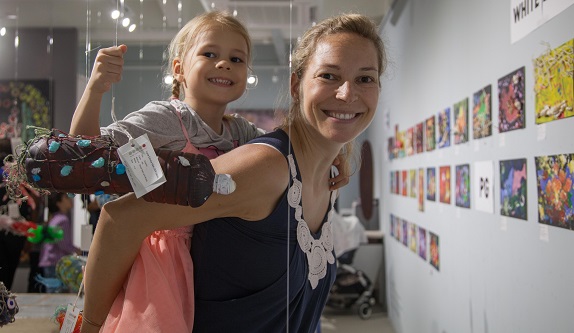One day out with Melrose Home kids perfectly summed up what Scouts is all about, Gerard Ward finds.

For one November afternoon, twenty kids from Melrose Home Children’s Aid Society spent some time with some new friends.
‘We’ve been talking for a year or so about doing something for a children’s home, perhaps playing football with them or something,’ 1st ANZA Scouts group coordinator Rachel Landau says. ‘Then [ANZA Action coordinator] Rae Moller came to the Scouts groups saying ANZA Action was looking at doing something with Melrose Home.’
One of the many children’s homes in Singapore, Melrose Home has been providing care, support and protection to children between the ages of 4 to 18. ANZA has been a big supporter of the charity, and it seemed fitting to try and make the best of what we have to offer.
The original plan was to host a family fun day that was charity-focused, but an event of that scale wasn’t plausible at the time. Some time had passed before the idea to have an afternoon with the kids came to fruition.
For 1st ANZA Scouts, this was an opportunity to offer something to the local community, harnessing what they’ve learned at past meetups and classes for a great day of fun.
‘One of our leaders, James Mansfield-Page, was one of the main driving forces behind this,’ Rachel Landau says – James had been an ANZA Scout when younger, and has continued playing a big part in Scouts, wanting to help out after finishing National Service.

James Mansfield-Page talks to the 1st ANZA Scouts before the kids arrive.
Held at the Sarimbun Scout Camp, a ‘lovely big area that’s quite wild by Singaporean standards’, the afternoon is set to be full of games run by the Scouts – getting the kids to interact and have a bit of fun. ‘Because it’s SG50, we managed to get everyone SG50 scarves from the Singapore Scouts shop,’ Rachel says.
Not a moment after the kids had excitedly gotten off the bus and got their scarves tied by the Scouts that the rain starts bucketing down. ‘At the campsite there’s a big pergola area, it’s a permanent structure,’ Landau explains. ‘It was $200 to book it, and I’m thinking whether to spend the money on this, because we’d only need it if it rains. It was the best $200 I ever spent.’
Not one for backing down to a challenge, the Scouts are able to change some of the activities around to fit the space that wasn’t getting pummelled by water. There’s an arts and craft section where kids can create Christmas trees with coloured paper. ‘The kids really enjoyed the one-on-one attention as they were creating and drawing,’ Landau says.
First aid skills come in handy for the Scouts, who show the new recruits how to lug someone around in a homemade stretcher using only a couple of old t-shirts and some long poles.
Thinking games, like everyone holding hands and trying to untangle each other to make a circle, are great team-building exercises.
‘As with two bunches of kids of that age that don’t know each other, they tended to gravitate towards the ones they know,’ Landau says. ‘But the kids just needed a little bit of a nudge to start working together more, they were both terrific groups.’
A couple of moments that stand out the most for the organisers of the day surrounds food. The two gas burners at the opposite end of the campsite can’t be brought over to the covered area – due to the torrential rain – to help cook the chicken pasta dinner.
Luckily the woman running the campsite on the day allows the older Scouts, set with the task of cooking for 40 people, to use her kitchen. With a very small working space, two burners and a very large sink – as well as a whole bunch of ingredients to chop – the boys get to work, improvising with what they had to cook up a feast – demonstrating how prepared a Scout can be in a new situation. ‘So as these boys were chopping and preparing everything, some of the kids at the arts and craft came over and wanted to stand and chat as they were cooking the chicken,’ Landau says. ‘I think they just really enjoyed being somewhere different, having someone different to chat to.’
Not only do the visitors enjoy dinner, but are happily lining up to get seconds. There was no “eww, I don’t like this”, just pure appreciation.

The ANZA 1st Scouts successfully start the campfire.
The rain stops just early enough for the Scouts to set up a campfire – the classic scenario for the Scouts and kids to chat and mingle. ‘What was lovely to see was when the campfire was ready, our Scouts were saying “come on come on” and getting the kids to go to the campfire,’ Landau says.
Marshmallows are brought out and toasted, skits and shaggy dog stories are told, and the fire roars well into the night. As the bus pulls up to take the kids home, the rain is creeping back up to end the afternoon ceremoniously.
One of the parents writes a message to Rachel afterwards, thanking ANZA Scouts for the opportunity. ‘”Our son really enjoyed it and it made him very appreciative of what he has”,’ she says of the note. Clearly a highlight for both the Melrose Home kids and the Scouts involved, and with plenty of exciting stuff planned for 2016, it’s surely not going to be the last.










 Image Courtesy Long Chim
Image Courtesy Long Chim


